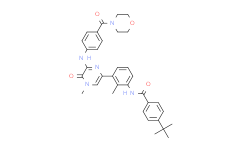| Cas No.: | 910232-84-7 |
| Chemical Name: | 4-Tert-butyl-N-[2-methyl-3-[4-methyl-6-[4-(morpholine-4-carbonyl)anilino]-5-oxopyrazin-2-yl]phenyl]benzamide |
| Synonyms: | N-[3-[4,5-Dihydro-4-methyl-6-[[4-(4-morpholinylcarbonyl)phenyl]amino]-5-oxo-2-pyrazinyl]-2-methylphenyl]-4-(tert-butyl)benzamide;CGI-1746;4-tert-butyl-N-[2-methyl-3-[4-methyl-6-[4-(morpholine-4-carbonyl)anilino]-5-oxopyrazin-2-yl]phenyl]benzamide;C34H37N5O4;Cgi 1746;4-tert-butyl-N-(2-methyl-3-{4-methyl-6-[4-(morpholine-4-carbonyl)-phenylamino]-5-oxo-4,5-dihydro-pyrazin-2-yl}-phenyl)-benzamide;CGI1746,2;CS-0252;CGI1746;4-(tert-Butyl)-N-(2-methyl-3-(4-methyl-6-((4-(morpholine-4-carbonyl)phenyl)amino)-5-oxo-4,5-dihydropyrazin-2-yl)phenyl)benzamide;GCI1746;4-Tert-Butyl-N-[2-Methyl-3-(4-Methyl-6-{[4-(Morpholin-4-Ylcarbonyl)phenyl]amino}-5-Oxo-4,5-Dihydropyrazin-2-Yl)phenyl]benzamide;GTPL8066;BDBM36516;SYN1164 |
| SMILES: | O1C([H])([H])C([H])([H])N(C(C2C([H])=C([H])C(=C([H])C=2[H])N([H])C2C(N(C([H])([H])[H])C([H])=C(C3C([H])=C([H])C([H])=C(C=3C([H])([H])[H])N([H])C(C3C([H])=C([H])C(=C([H])C=3[H])C(C([H])([H])[H])(C([H])([H])[H])C([H])([H])[H])=O)N=2)=O)=O)C([H])([H])C1([H])[H] |
| Formula: | C34H37N5O4 |
| M.Wt: | 579.6887 |
| Purity: | >98% |
| Sotrage: | 2 years -20°C Powder, 2 weeks 4°C in DMSO, 6 months -80°C in DMSO |
| Description: | CGI-1746 is a potent and highly selective inhibitor of the Btk with IC50 of 1.9 nM. |
| In Vivo: | CGI1746 abrogates B cell-dependent arthritis. CGI1746 treatment (100 mg/kg, s.c, twice-daily dosing) results in significant inhibition (97%) of overall clinical arthritis scores. CGI1746 treatment substantially reduces TNFα, IL-1β and IL-6, as well as MCP1 and MIP-1α on both the mRNA and protein level in the passive anti-collagen II antibody-induced arthritis (CAIA) model. CGI1746 shows comparable efficacy to TNFα blockade and significantly reduces clinical scores, as well as joint inflammation, in mice or rats with established arthritis[1]. |
| In Vitro: | CGI1746 is specific for Btk, with appr 1,000-fold selectivity over Tec and Src family kinases. In an ATP-free competition binding assay, the dissociation constant for Btk is 1.5 nM. CGI1746 inhibits Btk activity in a new binding mode that stabilizes an inactive nonphosphorylated enzyme conformation. CGI1746 inhibits both auto- and transphosphorylation steps necessary for enzyme activation. CGI1746 completely inhibits anti-IgM-induced murine and human B cell proliferation, with IC50s of 134 nM and 42 nM, respectively, but has no effect on anti-CD3- and anti-CD28-induced T cell proliferation. CGI1746 potently inhibits the proliferation of CD27+IgG+ B cells isolated from the tonsils of four human donors with an average IC50 of 112 nM. In macrophages, CGI1746 abolishes FcγRIII-induced TNFα, IL-1β and IL-6 production. CGI1746 potently inhibits TNFα, IL-1β and, to a lesser extent, IL-6 (three- to eight-fold higher IC50) production in human monocytes stimulated with immobilized or soluble immune complexes[1]. CGI-1746 does not kill cells as well as the irreversible BTK inhibitors at the same drug concentration. CGI-1746 significantly reduces phosphorylation of both the BTK-A and BTK-C proteins, indicating the auto-phosphorylation of the BTK-C isoform is inhibited in a manner similar to BTK-A. CGI-1746 does not kill LNCaP or DU145 prostate cancer cells at the same concentrations as Ibrutinib or AVL-292, but it demonstrates similar inhibition of BTK phosphorylation at tyrosine 233 in the SH3 domain[2]. |
| Cell Assay: | 5×103 DU145 cells or 104 LNCaP cells per well, grown on 96 well plates for 24h, are treated with 1 to 30 µM BTK inhibitors. Cells are fixed after 72h with 2.5% formaldehyde, and stained with Hoechst 33342. Control cells are treated with DMSO. Cell images are acquired using an IN Cell Analyzer 2200 high content imaging system, with a 20X objective. At least 9 fields are imaged per single well of each experiment. Cell numbers are determined and statistics performed using IN Cell Investigator 3.4 high content image analysis software. Each experiment is replicated 3 times, and data are presented as mean±SD. Results are considered significant if p < 0.05. |
| References: | [1]. Di Paolo, Julie A. et al. Specific Btk inhibition suppresses B cell- and myeloid cell-mediated arthritis. Nature Chemical Biology (2011), 7(1), 41-50 [2]. Kokabee L, et al. Bruton's tyrosine kinase is a potential therapeutic target in prostate cancer. Cancer Biol Ther. 2015;16(11):1604-15. |

 To enhance service speed and avoid tariff delays, we've opened a US warehouse. All US orders ship directly from our US facility.
To enhance service speed and avoid tariff delays, we've opened a US warehouse. All US orders ship directly from our US facility.




















